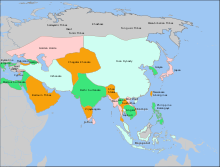Turco–Mongol tradition
Appearance

The Turco-Mongol or Turko-Mongol tradition was a cultural synthesis that arose during the early 14th century among the ruling elites of Mongol Empire successor states such as the Chagatai Khanate and Golden Horde. These elites adopted Turkic languages and different religions such as Buddhism and Islam, while retaining Mongol political and legal institutions.[1] Many later Central Asian states drew heavily on this tradition, including the Timurid Empire, the Khanate of Kazan, the Nogai Khanate, the Crimean Khanate, and the Mughal Empire.
See also
- Islam in Central Asia
- Mongol invasions and conquests
- List of Turkic dynasties and countries
- List of Mongol states
- Turko-Persian tradition
References
- ^ Beatrice Forbes Manz (1989). The Rise and Rule of Tamerlane. Cambridge University Press. pp. 6–9. ISBN 978-0-521-34595-8.
